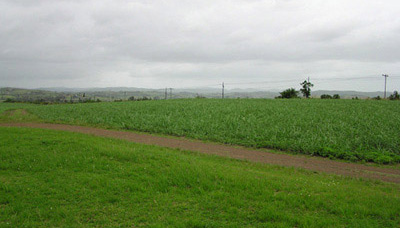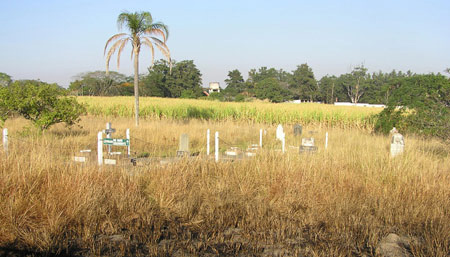
 |
| you are currently viewing: {Location Field} |
Gingindlovu, Wednesday, 2nd April 1879Keith I. SmithThree columns had entered Zululand in January 1879. Of these, the Centre Column had been heavily defeated in the battle at Isandlwana on the 22nd, following which it withdrew into Natal. On hearing the news of the disaster, Col. Evelyn Wood’s 4th Column withdrew to a new camp at Khambula to the north. Only Col. Pearson’s First Column on the coast remained in enemy territory. It had fortified the mission station at Eshowe but it was soon besieged at a distance by Zulu forces and communications were quickly cut off. Pearson’s men were gradually reduced by sickness and his supplies were dwindling. It thus became a necessity for Lord Chelmsford to relieve him as soon as reinforcements became available from Britain.  On the 29th March 1879 the Eshowe relief column under the personal command of Lord Chelmsford marched north after crossing the Thukela during the preceding days. It was a formidable force of two brigades. The first brigade, under the command of Lt-Col. F.T.A. Law R.A., consisted of the following:
The second brigade, under W.I. Lt-Col. Pemberton, 60th Rifles, comprised the following units:
In addition, the following elements made up the mounted troops under the command of Major P.H.S. Barrow:
Unlike Pearson before him, Lord Chelmsford chose to follow a line closer to the coast, and thus avoid the more difficult ground inland. His progress, however, like that of Pearson, was interrupted by an engagement with a Zulu force sent by King Cetshwayo. The Zulu attack was even less successful than the first one at nearby Inyezane on 22nd January, largely because the Lieutenant-General had by now recognised the need for a laager and entrenchments, and had amended his Field Regulations accordingly. On 1st April, the column reached the Gingindlovu stream, about a mile short of the Nyezane river to the north. The camp was set out on a low knoll which had a reasonable view of the surrounding ground. A couple of hundred yards to the north-east lay the burnt-out ruin of the Gingindlovu military ikhanda destroyed by Pearson on his progress north. 
The laager consisted of wagons drawn up around an area 170 yards long on two sides, the other sides being about 100 yards and 70 yards. The wagons were drawn up lengthwise, all cattle, and horses being inside the square, while on the outside a shelter trench was thrown up about twenty yards from the wagons, the bank about thirty inches high being thrown up from a trench eighteen inches deep.
Chelmsford described the surrounding area: On the following morning, the troops stood to their arms at 4 a.m. Quite by chance, Lord Chelmsford had already decided to remain in laager on that day and continue his advance on the 3rd. There was a heavy mist which obscured the surrounding country which began to burn off as the sun rose at 6.15. Even before that time, the mounted men were out and about scouting the area. At 5.45, reports came in from two separate infantry pickets that the Zulu were gathering for an attack. “… no preparation was necessary and no orders had to be given beyond the saddling up of the horses of the Officers of the Staff; the troops were already at their posts, and the cattle had not been let out to graze.” Lord Chelmsford described the manning of the laager: 
The NNC battalions were held inside the laager and the wagons were used as firing posts by the armed non-combatants, including Commandant George Hamilton-Brown. The Zulu advanced on the laager very rapidly, and Captain Barton, commanding the 4th Batt. NNC, described them as ‘fighting magnificently, I never saw such splendid skirmishing”. The attack took the traditional form, the ‘chest’ attacking from the north, or Nyezane, while the left horn moved round to attack from the direction of the Gingindlovu ruins. The right horn came from the direction of Umisi hill to the west, while a component of the same force separated and launched an attack from the south. Lord Chelmsford described the first onset of the Zulu assault: The attack, checked here, rolled round to the west, or left face; … Whilst this was being developed, a fresh force came round to the rear, probably from the Umisi Hill, anticipating (so prisoners state) that our force would prove insufficient to defend, at the same time, all the faces of the laager; here they obstinately held their ground, finding cover in long grass and undulations. The mounted men had meanwhile left the laager and were clearing the north face of the laager. They were now directed to advance across the east face and attack the Zulu left horn. By 7.30 the Zulu had succeeded in attacking only three faces of the square and had nowhere penetrated to a point where hand-to-hand combat was possible. It soon became clear that the Zulu attack was faltering and at this moment the two battalions of NNC were sent out from the south face to attack the hesitating warriors, led by the mounted men. By 8 a.m., Pearson, who had watched the engagement throughout, flashed his congratulations on a decisive victory. The British lost 9 killed, including Brevet Lt-Col. F.V. Northey, 60th Rifles. It was estimated that the Zulu force of some 11,000 men had lost to almost 1,200 men. On the following day, leaving a small force to garrison the laager, Lord Chelmsford continued his march and relieved the Eshowe garrison that same day, the last elements of the column arriving at Eshowe about 11 p.m. 
© Text and photographs, Keith I. Smith. |